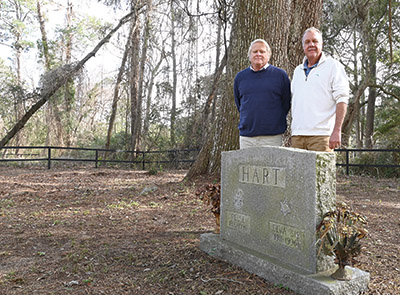Land use
Development moving forward as lawsuit moves through courts

Tripp Nealy and Beth Martin met for the first time this week across a drainage ditch. Their attorneys have met in court.
Nealy is about to start sales at Magic Oaks, a 27-lot development between Pawleys Creek and Highway 17. He is moving forward in spite of a lawsuit by Martin and four other neighbors who are asking the Circuit Court to overturn Georgetown County’s rezoning of the property.
Nealy said he was assured by his lawyer that the development could move forward with the suit still pending. The plaintiffs have appealed a judge’s ruling that struck out a portion of their complaint. That is now pending before the state Court of Appeals.
“I don’t think I’ll lose the suit,” Nealy said.
An open house for real estate brokers is planned for today. Nealy invited the press to the property this week to tell how he came to acquire the property and what he plans to do with it. He said he’s tired of being “bashed” by the citizens group Keep It Green, which is not a party to the suit. He has filed a counterclaim against the group as well as the plaintiffs, alleging they conspired to delay the project and seeking damages.
“I want to be a neighbor to these people, but something’s got to change,” Nealy said. “I never had one person to approach me, not even a phone call to say, ‘Tripp, what are you doing?’ I just got served papers.”
He pointed out that when he agreed to change the zoning from “general residential” to a “flexible design district” to limit the density, it was supported by the neighbors and Keep It Green.
The lawsuit challenges the rezoning, in part, because the 8.3 acres at Magic Oaks were shown on the maps that are part of the county’s comprehensive plan as “conservation preservation.” It argues that the zoning change was invalid because the previous zoning didn’t comply with the comprehensive plan as required by state law.
Cindy Person, chief counsel for Keep It Green Advocacy, represents the neighbors. She said that although they didn’t approach Nealy, they did contact the project engineers and asked to conduct an independent study of wetlands on the Magic Oaks site.
“They really didn’t feel confident about the wetlands study,” she said.
When they were rebuffed, they didn’t see the need to talk further, Person said.
It isn’t too late to allow the study, at the plaintiffs’ expense, she added.
“That is the starting point,” Person said. “It could answer a lot of questions.”
When Nealy and Martin met, they talked about the ditch, which Martin said needs to be cleaned so stormwater doesn’t back up onto her property and become a breeding ground for mosquitoes.
Nealy said he’s willing to make improvements to the ditch, which also drains an area west of Highway 17, if Georgetown County will let him. He and Martin disagreed about the best method to do that.
While Nealy seemed frustrated, he said he still wants to talk.
“I’m a grown man. If they’ll sit down with me, I will find a way to make this thing work,” he said.
Under the previous zoning, he said, he could have built more than 140 units and 30,000 square feet of commercial space. But Nealy thinks the current plan is “the highest and best use” for the property. “This is going to be high-end housing,” he said.
It’s also the plan that was acceptable to the former owner, David Tanner, who is also named in the suit as the applicant for the zoning change.
Tanner inherited the property from Reese Hart, a chemist, inventor and magician. He met Hart as a teenager 51 years ago. Tanner was interested in magic and Hart encouraged him.
When Tanner learned that he was named in Hart’s will, he thought he might be getting something of sentimental value, like the old push lawnmower he used to cut Hart’s grass before Hart’s wife, Sis, made Hart buy a power mower. Instead, he inherited the bulk of Hart’s estate, including $1 million with the instruction to “go make the world a better place.”
Tanner lived on the property for 27 years. Even though he put it on the market, Tanner didn’t want to sell and didn’t return Nealy’s call offering to pay $3 million for it.
It sold for $3.9 million, and Tanner will get a house on one of the five creekfront lots, a spot where he and Hart used to fish.
“It wasn’t about the money,” Tanner said. “I really didn’t care about selling it.”
What he wanted to do was find a way to preserve Hart’s legacy, he said. Reese and Sis Hart are buried on the property along with several of their pets.
“I couldn’t just turn it over. It had to be something that I would have a little bit of control over,” Tanner said.
For Nealy, the property had more than creek access with a view of Pawleys Island. It had a story.
“This is the best piece of real estate around, and it’s got a hook in it that you can’t even imagine,” Nealy said. “It’s got a story to it. A great one.”
The story of the eccentric magician will be told in the community center next to the grave site and not far from the spot where Tanner helped Hart mix up a batch of some secret elixir, stirring it with a boat paddle. “He said you had to keep stirring it or it would explode,” Tanner said. “That’s why you had to make it outside.”
But before that happens, Nealy hopes to make the lawsuit disappear. He said he appreciates the passion that Keep It Green and others have for protecting the community’s character. That should be directed at the “stock market builders” who build homes by the hundreds, he said.
“I want to be passionate about what I do, and I don’t want to quit,” Nealy said. “Give me a chance.”




